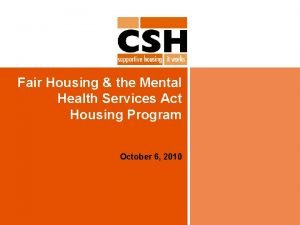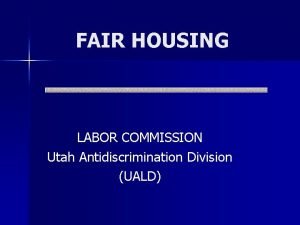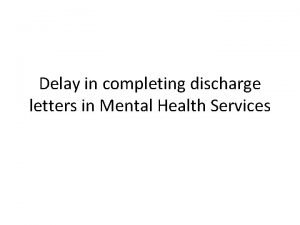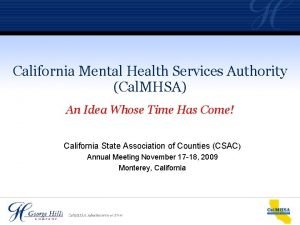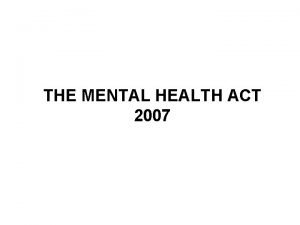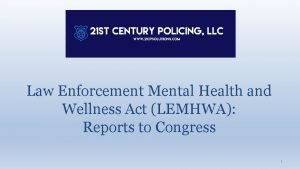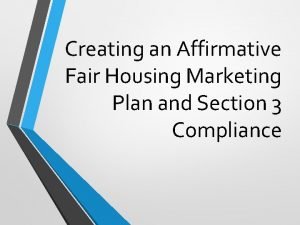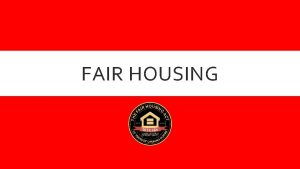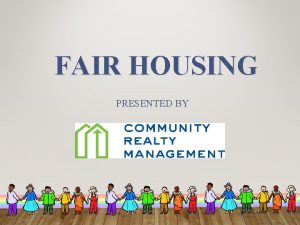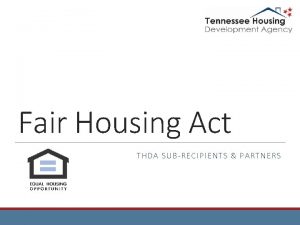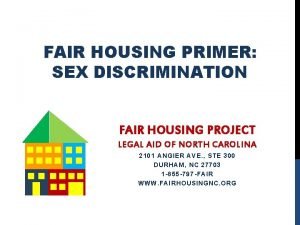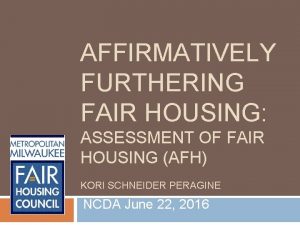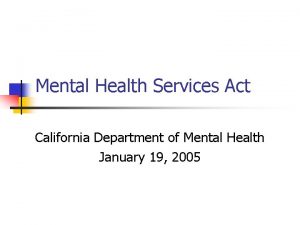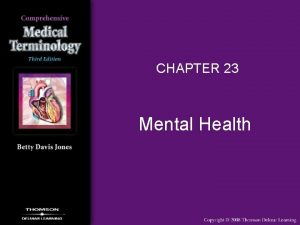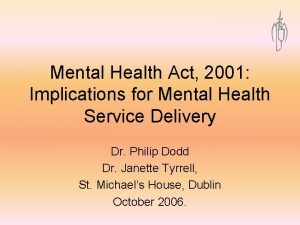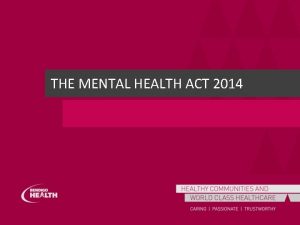Fair Housing the Mental Health Services Act Housing




















- Slides: 20

Fair Housing & the Mental Health Services Act Housing Program October 6, 2010

Overview n n n Between the Lines Guide Fair Housing Concepts – Disparate Impact – Discrimination in Favor of People with Mental Illness Mixing Federal Funds with MHSA Housing Funds – Integration of MHSA Units – FSP Participation as a Condition of Tenancy Tenant Selection Process – Allowable Questions – Tenant Input Into Applicant Screening Zoning Issues Community Care Licensing

Between the Lines: A Question & Answer Guide on Legal Issues in Supportive Housing n Latest edition published in January 2010 – To address changes in law and policies – To incorporate MHSA Housing Program requirements – As w/2003 edition, written to provide guidance in developing and operating PSH, not concrete guidance on specific legal situations—still circumstances where legal counsel is required

2010 Edition of BTL n www. CSH. org, click on Resources, click on Publications, under “Recent Publications. ” In 2 downloads: chapters & appendices

Fair Housing Principles n The Federal Fair Housing Act and the California Fair Employment and Housing Act prohibit discrimination in housing on the basis of: – Race, Color, Religion, Sex, National Origin, Familial Status, Disability, Sexual Orientation, Source of Income, Marital Status, Ancestry. – Any housing provider may run afoul of fair housing laws if the housing provider’s tenant selection policies negatively impacts members of one of the protected classes, even if unintentionally.

Targeting Homeless People n n Targeting housing for homeless people, chronically homeless people, or people with disabilities does not violate any fair housing laws. A housing provider can discriminate in favor of groups if the discrimination— • Is necessary to achieve a public policy purpose compelling enough to override the discriminatory effect and • Effectively carries out the intended purpose.

Disparate Impact n A policy/law/program that, on its face, discriminates against a “protected class” of people violates Fair Housing laws. – Example: a city limit on the number of people with disabilities who may benefit from a housing trust fund. n A policy/law/program that does not seem to discriminate and is outwardly neutral, but has a disproportionately adverse impact on protected class of people (“disparate impact”) also violates Fair Housing laws. – Example: limiting a program to residents of a geographic area may disproportionately impact a protected class underrepresented in that area.

Disparate Impact n n To prove a disparate impact, a plaintiff has to show statistics indicating an adverse impact on a protected class. Defense: a legitimate non-discriminatory business reason that necessitates the discrimination and that effectively carries out the purpose; no feasible alternatives exist. – Example: an argument that limiting a program to county residents is necessary due to limited resources could be rebuffed in favor of less discriminatory means of limiting the number of participants (i. e. , could have a wait list). n Zoning laws that have a disparate impact on people with disabilities require additional zoning decision justification.

Discrimination in Favor of People with Serious Mental Illness n n The MHSA Housing Program has a “disparate impact” on people with disabilities without serious mental illness. However, discrimination allowed when necessary to afford individuals equal access to housing and services otherwise denied because of a disability.

Using Federal Funding in an MHSA Housing Project • Section 504 of the Rehabilitation Act applies to programs receiving federal funding (except tax credits): – Though 504 restricts ability to set aside units for people with specific types of disabilities— • May limit occupancy to people with a type of disability if a federal statute or executive order authorizes limitation (i. e. , HOPWA). • Distinctions on the basis of disability are permitted if necessary to, “provide qualified individuals with handicaps with housing, aid, benefits or services that are as effective as those provided to others. ” Housing Program provides participants equal access to housing when the participants’ disabilities otherwise prevent them from accessing housing and services.

Using Federal Funding in an MHSA Housing Project n Restricting who is able to live in the housing must be based on reasons that are “rational: ” it is rational if the restrictions are related to the services being offered to the tenants (i. e. , limiting housing to people with serious mental illness is rational because the housing comes with mental health services). – Tricky to limit the housing to people with a specific diagnosis, like schizophrenia. n Housing should be advertised for homeless people who would benefit from the mental health services the housing offers, rather than specifying that only people with serious mental illness are eligible.

Using Federal Funding in an MHSA Housing Project n Integration mandate: – If a project for people with disabilities receives federal funding, it must comply with the integration mandate. – Requires housing providers to promote tenancy in the “most integrated setting possible. ” Tenants should live in a setting where they interact regularly with people without disabilities or without the same type of disability. – Small projects (fewer than 10 units) and shared housing can use MHSA funds for all units without violating the integration mandate. – Larger projects should ideally include a mix of MHSA and non-MHSA units.

Using Federal Funding in an MHSA Housing Project n FSP participation: – Section 504 and Olmstead promote tenants with disabilities living independently in a non-institutional setting. Tenants should not have fewer rights or greater responsibilities to access or maintain housing by virtue of their disability than others would. – Tenants should have the rights and responsibilities of tenancy. – In addition to violating MHSA requirements, mandating participation in FSP services could be challenged as requiring more of tenants due to their disability. – Can rely on referrals from FSP service providers, as long as county has balanced plan.

Tenant Selection Process n In determining whether to admit an applicant, housing providers may ask: – – n n Whether the applicant has been certified as FSP eligible. About the applicant’s ability to meet the terms of the tenancy. Whether the applicant uses illegal substances. If the applicant has ever been convicted of the illegal manufacture or distribution of a controlled substance. Cannot inquire into the nature or severity of the applicant’s disability or the applicant’s psychosocial history. Can do a criminal check and ask about criminal history to determine whether the applicant can meet the terms and conditions of tenancy, but may need to accommodate people incarcerated because of their disability.

Tenant Selection n Involving existing tenants in the selection process: – Housing provider is liable for any violations of fair housing laws committed by anyone participating in selection process. – Privacy laws prohibit existing tenants from being informed of an applicant’s disability status. If only screening for MHSA units, may be difficult not to inadvertently disclose to existing tenant screeners that applicants have a mental disability. – Tenants participating in the screening process should be trained on fair housing laws and permissible questions. – Shared housing: California law requires tenant involvement in selecting other shared housing tenants, though confidentiality laws still apply.

Zoning n Housing element law: – Cities must identify needs for housing for people with disabilities and for people who are homeless (“housing element”). – Cities must identify sites for supportive housing and remove restrictions on creating supportive housing in those sites. – In zoning any geographic area, a jurisdiction must treat supportive housing the same as housing of the same type. • Supportive housing should generally be considered multifamily housing for zoning purposes. • Shared housing should be considered a single family home, duplex, triplex, or quadraplex, for zoning purposes, rather than a “group home. ”

Zoning n n Zoning restrictions that treat housing for people with disabilities differently than other housing violates fair housing laws. Reasonable accommodation applies: jurisdictions must provide a reasonable accommodation to create housing if — – People with disabilities will occupy the housing; – The accommodation is necessary to give people with disabilities an equal opportunity to use the housing; and – The accommodation will not impose a fundamental or substantial alteration to the city’s land use plans/program. Every jurisdiction’s housing element must identify the process for requesting a reasonable accommodation.

Community Care Licensing n Supportive housing can provide “community living support services, ” but be exempt from community care licensing requirements if it meets the law’s definition of supportive housing: – Rental housing affordable to people with disabilities; – Tenants have a rental agreement with the rights and responsibilities of tenancy, subject to landlord-tenant laws; – Tenants each have own room or apartment with the right to choose roommates for shared tenancy; – No limit on the length of stay (permanent housing); and – Participation in services is not a condition of tenancy.

Community Care Licensing n Monitoring or assisting tenants in taking medication, assisting tenants in accessing medical or dental care, etc. , are allowed in supportive housing without a license if the services— – Help tenants live independently; – Educate or train tenants in managing medications, maintaining a budget, shopping, getting a job, etc. ; – Assist tenants in coordinating health care needs. n A supportive housing provider may contract with licensed medical, dental, or mental health providers to offer services onsite in certain circumstances (usually limited to 20 hours/week).

Contact Info Questions? ? Sharon Rapport CSH, Los Angeles sharon. rapport@csh. org Cell: (323) 243 -7424 Office: (213) 623 -4342, ext. 110
 Fair housing act mental illness
Fair housing act mental illness Utah fair housing act
Utah fair housing act Mental health and mental illness chapter 20
Mental health and mental illness chapter 20 Jeopardy mental health
Jeopardy mental health Bexar county mental health services
Bexar county mental health services Mental health discharge letter
Mental health discharge letter West cork mental health services bantry
West cork mental health services bantry California mental health services authority
California mental health services authority Sonnet with 14 lines
Sonnet with 14 lines Foul is fair and fair is foul literary device
Foul is fair and fair is foul literary device Aside literary device
Aside literary device Fair is foul and foul is fair macbeth
Fair is foul and foul is fair macbeth Syntax rhetorical device
Syntax rhetorical device Play significa
Play significa Examples of fair is foul and foul is fair in macbeth
Examples of fair is foul and foul is fair in macbeth Mental health act 2007 summary
Mental health act 2007 summary Lemhwa report to congress
Lemhwa report to congress Immokalee fair housing alliance
Immokalee fair housing alliance Affirmative fair housing marketing plan sample
Affirmative fair housing marketing plan sample Examples of affirmatively furthering fair housing
Examples of affirmatively furthering fair housing Fair housing delaware
Fair housing delaware
